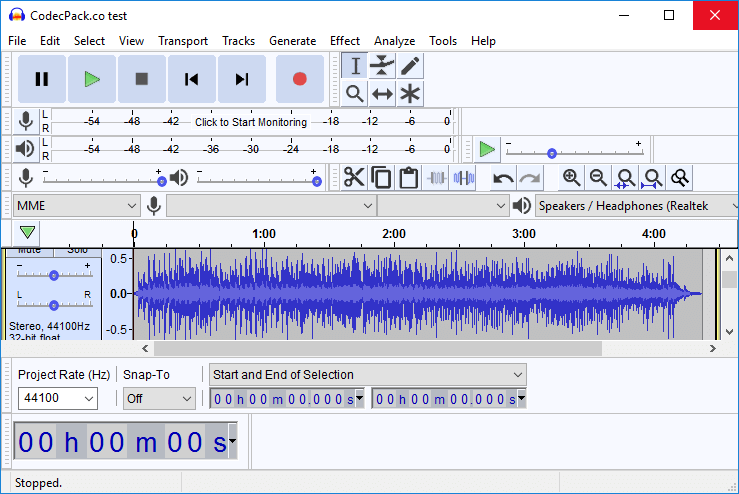Lame_enc
Download missing DLL files for free to fix DLL errors ⌚ If you need help installing DLL files, you will need our DLL fix software ⌚ Dll files for free - no registrations. LAME은 LGPL라이센스기반의 고화질mp3 인코딩 을 도와주는 DLL입니다. LAME is a high quality MPEG Audio Layer III (MP3) encoder licensed under the LGPL. Lame MP3 Codec lameenc.dll インストールを参考に. Lame-3.97.zipファイルをダウンロードの上、展開してください。 フォルダーの中に、lameenc.dllというのがあると思います。. LAME is a high quality MPEG Audio Layer III (MP3) encoder licensed under the LGPL. Latest LAME release: v3.100 (October 2017) LAME development started around mid-1998.
LAME v3.99.5 running under Linux | |
| Developer(s) | The LAME development team |
|---|---|
| Initial release | 1998; 23 years ago |
| Stable release | |
| Repository | https://sourceforge.net/p/lame/svn/HEAD/tree/ |
| Operating system | Cross-platform |
| Type | Codec |
| License | GNU Lesser General Public License[2] |
| Website | lame.sourceforge.net |
LAME is a software encoder that converts a digitized WAV audio file into the MP3audio coding file format. LAME is a free software project that was first released in 1998, and has incorporated many improvements since then, including an improved psychoacoustic model. The LAME encoder outperforms early encoders like L3enc.[3]
LAME was required by some programs released as free software in which LAME was linked for MP3 support, but the patent has expired. This avoided including LAME itself, which use patented techniques, and so required patent licenses in some countries. For instance, it is now bundled with Audacity),[4]
History[edit]
The name LAME is a recursive acronym for 'LAME Ain't an MP3 Encoder'.[5]
Around mid-1998, Mike Cheng created LAME 1.0 as a set of modifications against the '8Hz-MP3' encoder source code. After some quality concerns raised by others, he decided to start again from scratch based on the 'dist10' MPEG reference software sources. His goal was only to speed up the dist10 sources, and leave its quality untouched. That branch (a patch against the reference sources) became Lame 2.0. The project quickly became a team project. Mike Cheng eventually left leadership and started working on tooLAME (an MP2 encoder).
Mark Taylor then started pursuing increased quality in addition to better speed, and released version 3.0 featuring gpsycho, a new psychoacoustic model he developed.

A few key improvements, in chronological order:
- May 1999: a new psychoacoustic model (gpsycho) is released along with LAME 3.0.
- June 1999: The first variable bitrate implementation is released. Soon after this, LAME also became able to target lower sampling frequencies from MPEG-2.
- November 1999: LAME switches from a GPL license to an LGPL license, which allows using it with closed-source applications.
- May 2000: the last pieces of the original ISO demonstration code are removed. LAME is not a patch anymore, but a full encoder.
- December 2003: substantial improvement to default settings, along with improved speed. LAME no longer requires users to enter complicated parameters to produce good results.
- May 2007: default variable bitrate encoding speed is vastly improved.
Lame_enc.dll
Patents and legal issues[edit]
Like all MP3 encoders, LAME implemented techniques covered by patents owned by the Fraunhofer Society and others. The developers of LAME did not license the technology described by these patents. Distributing compiled binaries of LAME, its libraries, or programs that derive from LAME in countries where those patents have been granted may have constituted infringement, but since 23 April 2017, all of these patents have expired.[6][7]
The LAME developers stated that, since their code was only released in source code form, it should only be considered as an educational description of an MP3 encoder, and thus did not infringe any patent in itself. They also advised users to obtain relevant patent licenses before including a compiled version of the encoder in a product.[8] Some software was released using this strategy: companies used the LAME library, but obtained patent licenses.
In the course of the 2005 Sony BMG copy protection rootkit scandal, there were reports that the Extended Copy Protectionrootkit included on some SonyCompact Discs had portions of the LAME library without complying with the terms of the LGPL.[9][10][11]
See also[edit]
- MP3, ID3
Lame_enc.dll Audacity
References[edit]
- ^'History'. Archived from the original on
|archive-url=requires|archive-date=(help). Retrieved 15 October 2017. - ^http://lame.cvs.sourceforge.net/viewvc/lame/lame/COPYING?revision=1.2&view=markup
- ^'Opus FAQ'.
This is what made it possible for modern MP3 encoders (e.g. LAME) to improve far beyond the original L3enc and dist10 reference implementations.
- ^Lendino, Jamie (27 September 2019), 'Audacity Review', PC Magazine
- ^'LAME MP3 Encoder :: About'. Lame.sourceforge.net. Retrieved 17 March 2012.
- ^'mp3'. Fraunhofer IIS. Fraunhofer IIS. Retrieved 2 May 2017.
- ^'Alive and Kicking: MP3 software, patents and licenses (Fraunhofer Audio Blog)'. Fraunhofer Audio Blog. Fraunhofer IIS. 18 May 2017. Retrieved 19 May 2017.
The licensing program coming to an end is due to the fact that the last patent included in the program expired.
The page's later caution about third-party implementation–specific patents is not about LAME's implementation. - ^http://lame.sourceforge.net/tech-FAQ.txt
- ^Reuters (21 November 2005). 'Sony BMG Software May Contain Open-Source Code'. Fox News. Retrieved 26 November 2011.CS1 maint: uses authors parameter (link)
- ^'Is Sony in violation of the LGPL?'. The-interweb.com. Retrieved 17 March 2012.
- ^'Sony's XCP DRM'. Archived from the original on 24 November 2005.
Lame_encode_buffer_ieee_float

External links[edit]
Lame_enc.dll
- LAME binaries - RareWares
- LAME binaries for Audacity - recommended for the Audacity free and GPL audio editor
- LAME Wiki - HydrogenAudio
Lame Enc Dll Mp3
